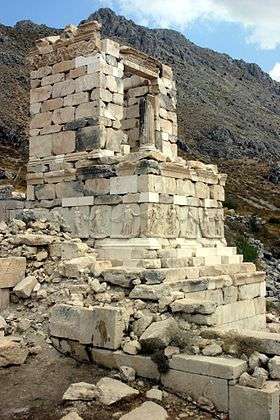Heroon

A heroon or herõon (/hᵻˈroʊ.ɒn/; Greek ἡρῷον, plural ἡρῷα, heroa), also called heroum, was a shrine dedicated to an ancient Greek or Roman hero and used for the commemoration or cult worship of the hero. It was often erected over his or her supposed tomb or cenotaph.
The Romans and the Greeks practised an extensive and widespread cult of heroes. Heroes played a central role in the life of a polis, giving the city a shared focus for its identity. The cult typically centred on the heroon in which the hero's bones were usually believed to be contained. In a sense, the hero was considered still to be alive; he was offered meals and was imagined to be sharing feasts. His allegiance was seen as vitally important to the continued well-being of the city. This led to struggles between Greek cities for control of heroic remains.
Greek literature records how Cimon of Athens avenged the death of the legendary hero Theseus in 469 BC, finding a set of bones allegedly belonging to the hero and returning with them in triumph to Athens. Similarly, Herodotus records in his Histories that the Spartans raided the heroon of the city of Tegea, stealing the bones of Orestes. This was regarded as changing the hero's allegiance from Tegea to Sparta, ensuring that the Spartans could defeat the Tegeans as foretold by the Oracle of Delphi.[1]

Many examples of heroa can be found around the tholos tombs of Mycenaean Greece and in or near the sacred areas of a number of Greek cities around the Mediterranean. A particularly well-preserved example, the so-called Tomb of Theron, can be found at Agrigento in Sicily. The Greek city of Paestum, south of Naples, has an unlooted heroon of an unknown figure, perhaps the city founder, with its contents intact (now in the museum there), including large metal vases. Another notable one, at Vergina in Greek Macedonia (the ancient city of Aigai - Αἰγαί), is thought to have been dedicated to the worship of the family of Alexander the Great and may have housed the cult statue of Alexander's father, Philip II of Macedon.
A well-preserved Roman heroon from the Augustan period is situated in the ancient city of Sagalassos in what is now Turkey. Another well-preserved and well-known heroon is the Library of Celsus in Ephesus, Turkey. It was built to honor a Roman senator, Tiberius Julius Celsus Polemaeanus, a consul and proconsul of Asia from 92 to 107 and governor of Asia when he died in 114. He bequeathed a large sum of money for its construction which was carried out by his son. Apart from the library in Alexandria, Egypt, it was one of the largest libraries of the ancient world.
References
Sources
- Parkins, Helen. Roman Urbanism. Routledge, 1997.
External links
| Look up herõon in Wiktionary, the free dictionary. |
- The 'Heroon' at Aigai
- Archaeology's Interactive Dig: Northwest Heroon, Archaeology, June-August 2006
_-_n._0355_-_Girgenti_-_Tomba_di_Terone_(2).jpg)